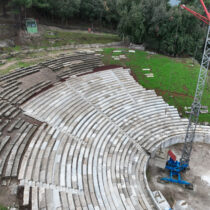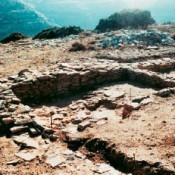The foundations of the Athena Pallenis temple, located during a rescue excavation by the II Ephorate of Prehistoric and Classical Antiquities, are being excavated at Stavros, Hagia Paraskevi, at the intersection of Androutsou and Zalogou streets since 1994. Made of limestone, the foundations belong to a doric hexastyle temple of around the mid-fifth century BC. The temple has been assigned by M. Korres to the well-known “architect of Theseion”, since it displays all the characteristics, typical of the other templed buildings that he created (temple of Poseidon at Cape Sounion, temple of Hephaistus at Theseion, temple of Nemesis at Ramnous). The very good preservation of the foundation walls allows a more or less accurate representation of the plan and superstructure of the temple. A large section of its southwestern and a smaller one of its north-western corner has unfortunately been destroyed by modern buildings, since the temple lies in a residential area in which systematic building inspection has only recently been established . The dimensions of the crepis are 36.25 x 16.35 m. while the foundations are preserved up to the fifth block of stone at the western side of the building. The sanctuary of Athena Pallenis was one of the most famous rural shrines of antiquity. The Archaic temple, of the age of Pesistratus, is mentioned by ancient authors such as Herodotus, Aristotle, Euripides, Aristophanes and others, but it has yet to be located. The area of ancient Palleni is also related to many ancient myths, such as the Gigantomachy, the Heracleids, and the myth of Theseus. According to local epigraphical data the sanctuary and temple of Athena Pallenis was the center of a federation in which Palleni, Gargettos, Paiania and propably Acharnes belonged and which lasted from the Archaic to the Roman period. Many marble members of the temple have been walled into Christian churches of the region, while only a few marble elements from its superstructure have been found in situ. This fact and the verified by excavational data termination of the temple’s function in the Roman era leads to the conclusion that the sanctuary was very probably transferred to another, better location, as is also the case with other temples, a custom prevalent in the years of Augustus’ reign. A depository of Geometric clay, bird-form figurines (8th-7th century BC) and various other clay and bronze offerings were excavated to the east of the temple in the last two years. The finds certify the existence of an important cult at the site, propably that of Athena Hippeia at an early stage.
The sanctuary of Athena Pallenis
21 Αυγ 2012
από Archaeology Newsroom
- A
- A
- A



